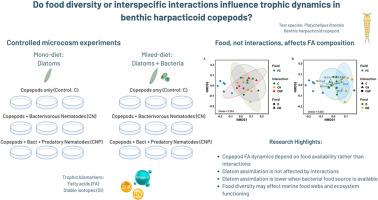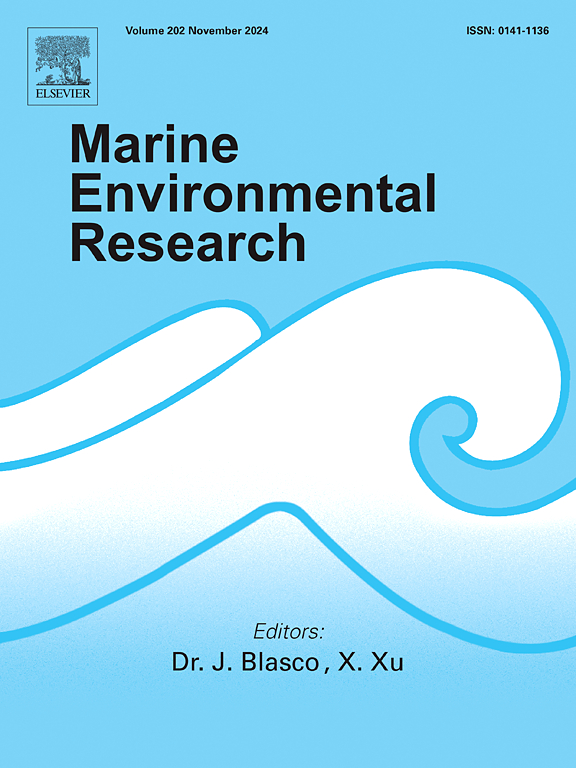超越竞争:食物的可获得性决定了底栖类羽足类桡足类动物和自由生活的线虫之间的营养相互作用。
IF 3.2
3区 环境科学与生态学
Q2 ENVIRONMENTAL SCIENCES
引用次数: 0
摘要
物种相互作用是生态系统功能的基本驱动力,但它们在构建底栖动物营养关系中的作用仍然知之甚少。我们研究了河口环境中两个最丰富的分类群,桡足类和线虫之间的生物相互作用,作为营养生态位的种间竞争的案例研究。通过对不同食物体系(单独硅藻与带细菌的硅藻)进行控制的微观实验,我们评估了食物成分或种间相互作用是否会影响实验物种——滨海鸭嘴龙(Platychelipus littoralis)的脂肪酸组成和食物同化。研究结果表明,潮间带底栖桡足类的营养动态主要是由食物资源多样性(单一与混合饮食)和质量构成的,而不是直接的种间竞争。缺乏相互作用对桡足动物生存、脂肪酸组成和食物同化的影响表明,生态位重叠并不一定导致竞争排斥,至少在中等食物供应下是这样。当有细菌食物时,桡足类动物的硅藻同化减少,但细菌吸收不受线虫存在的影响,表明营养灵活性。这些发现强调了食品质量和微生物组成在形成微生态系统相互作用和能量流动方面的重要性,以及将微生物-微生态系统联系纳入底栖生态系统功能研究的必要性。本文章由计算机程序翻译,如有差异,请以英文原文为准。

Beyond competition: food availability shapes trophic interactions between benthic harpacticoid copepods and free-living nematodes
Species interactions are fundamental drivers of ecosystem functioning, yet their role in structuring trophic relationships among benthic meiofauna remains poorly understood. We examine biotic interactions between the two most abundant taxa in estuarine environments, copepods and nematodes, as a case study of interspecific competition for trophic niches. Using controlled microcosm experiments with varying food regimes (diatoms alone vs. diatoms with bacteria), we assessed whether food composition or interspecific interactions influence fatty acid composition and food assimilation in our test species, the harpacticoid copepod Platychelipus littoralis. Our results demonstrate that trophic dynamics of intertidal benthic copepods are primarily structured by food resource diversity (single vs. mixed diet) and quality, rather than direct interspecific competition. The absence of interaction effects on copepod survival, fatty acid composition, and food assimilation suggests that niche overlap does not necessarily result in competitive exclusion, at least under moderate food availability. Copepods showed reduced diatom assimilation when bacterial food was available, but bacterial uptake was unaffected by nematode presence, indicating trophic flexibility. These findings underscore the importance of food quality and microbial composition in shaping meiofaunal interactions and energy flow, and the need to integrate microbial–meiofaunal linkages into studies of benthic ecosystem functioning.
求助全文
通过发布文献求助,成功后即可免费获取论文全文。
去求助
来源期刊

Marine environmental research
环境科学-毒理学
CiteScore
5.90
自引率
3.00%
发文量
217
审稿时长
46 days
期刊介绍:
Marine Environmental Research publishes original research papers on chemical, physical, and biological interactions in the oceans and coastal waters. The journal serves as a forum for new information on biology, chemistry, and toxicology and syntheses that advance understanding of marine environmental processes.
Submission of multidisciplinary studies is encouraged. Studies that utilize experimental approaches to clarify the roles of anthropogenic and natural causes of changes in marine ecosystems are especially welcome, as are those studies that represent new developments of a theoretical or conceptual aspect of marine science. All papers published in this journal are reviewed by qualified peers prior to acceptance and publication. Examples of topics considered to be appropriate for the journal include, but are not limited to, the following:
– The extent, persistence, and consequences of change and the recovery from such change in natural marine systems
– The biochemical, physiological, and ecological consequences of contaminants to marine organisms and ecosystems
– The biogeochemistry of naturally occurring and anthropogenic substances
– Models that describe and predict the above processes
– Monitoring studies, to the extent that their results provide new information on functional processes
– Methodological papers describing improved quantitative techniques for the marine sciences.
 求助内容:
求助内容: 应助结果提醒方式:
应助结果提醒方式:


